The most prolific tank of the interwar and until 1941, was the Soviet T-26. Based in 1930 on the British Vickers 6-ton tank (Mark E) it was successfully copied, then mass produced in three main models until 1941, above 10,000 units, making single-handedly the Soviet Tank force the world's largest at the time. However by the summer of 1941, the T-26 was now woefully obsolete. It was also declined into about fifty variants ranging from flamethrower to prime movers, armoured personal carriers, self propelled guns and engineering vehicles.
The previous Soviet mass-production tank, the T-18, a local design, was based on the small WWI era Renault FT. One decade had already passed, and the new Vickers tank embodied the advances of the time, or so they were advertised. This confidence in Vickers designs was renewed after the license for the Carden-Loyd Mk.VI tankette was acquired, built locally as the T-27. Another Vickers design also led to the amphibious T-37A. At the first press meetings and public tests, the tank drew the attention of Semyon Ginzburg, head of the Soviet buying committee, searching for tractors, cars, trucks and tanks.
They signed a contract for 15 Vickers 6-ton Model A (twin-turret) vehicles was signed on May 28, 1930, including full documentation and plans for domestic production. The 15 tanks were assembled in 1930 at Vickers, under the careful attention of Soviet engineers. The first vehicles arrived in the USSR during that fall, and the others in 1931-32 when the first domestic T-26 design was almost ready for production.
This tank alone made the Red Army, by far, the biggest armored force the world had ever seen. Even in the summer of 1941, German armor was overwhelmed by a four to one ratio and the Panzers would soon be confronted, on a daily basis, with swarms of such light tanks. Simply put, it was the mainstay of the Red Army, playing the same task during these pre-war years as the T-34 during the “Great Patriotic War”.
But as the complex T-19, although not ready on schedule, had some advantages over the Vickers, Ginsburg suggested the construction of a kind of hybrid, retaining only the engine and transmission from the Vickers. However, in January 1931, there were serious concerns about the purchase of the Vickers and Christie tanks by Poland, with mass-production possible afterward. At that time, the USSR only possessed an obsolete lot of WWI vintage British and French tanks and the now obsolescent fleet of T-18s.
So an order came to urge production of the T-26 with existing components. There were concerns about the better quality of British armor (the Vickers S.t.a Plat, high-quality cemented plates). This first prototype was a Vickers equipped with Soviet-built turrets, which was put under heavy machine-gun fire to check protection.
At the same time, the Faculty of Mechanization and Motorization of the Military Technical Academy produced two “low power tanks”, TMM-1 and TMM-2, proceeding with several engines and parts from other vehicles. They were not retained and the final T-26, if very close to the original Vickers, had many alterations. The T-26 was first produced by the Bolshevik Factory in Leningrad, the only one with equipment and significant experience, having recently mass-produced the T-18.
Later on, Factory No. 174 joined the effort, headed by chief engineer S. Ginzburg. But until 1935 quality flaws were frequent. In 1933, the production was also assumed by the Stalingrad Tractor Factory (STZ). In February 1941, the last T-26 left Factory N°174. The production lines were converted to the more complex T-50 but still managed to build spare parts, armor kits, turrets and convert about 130 T-26s as flame-throwing versions, with a KhT-133 device. They also repaired around 846 T-26 in active duty. T-26 model 1931-32: The twin-turret version
The earliest production model was a twin-turret type. Each turret had an observation slit, a round firing port for the DT machine-gun, armored plates riveted to a frame and even sealed zinc shims for improved waterproof performance and fording. The following year, a cover for the engine main air outlet window was added. The next models (1932-33) had a mixed construction, with a welded and riveted hull. Turrets were either riveted or welded, sometimes both, mixed with all-welded or riveted hulls.
These turrets existed in four different models and configurations, although still mounted in the same locations, with the same height and generally same features. All had a 240° arc of fire and armor ranging from 13 to 15 mm (0.51-0.59 in), although the very first 1931 models had only 10 mm (0.39 in) of mediocre alloy, susceptible to machine-gun fire. The model 1931 (100 units), 1932 (1361) and 1933 (576) were all twin-turreted versions. About 2038 were built in all. Their fighting value in 1939 was insignificant, so many were converted to other duties, and some for training.
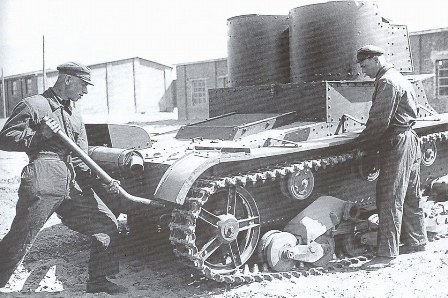
T-26 early production version (model 1932) under maintenance.
The Soviet gun, the 19K model 1932, was supplied with 122 rounds. Secondary armament consisted of a frontal coaxial 7.62 mm (0.3 in) DT machine gun and an additional one mounted on a rear external anti-aircraft cradle. In 1935, an extra one was mounted in a turret rear ball mount, all supplied by a total of 2961 rounds. These three machine-guns were provided to cope with dedicated anti-tank crews and effectively did their job against Japanese suicide squads at the battle of Khalkin Gol in 1939 (Mongolia). The 19K (and later 20K) 45 mm (1.77 in) guns fired anti-tank rounds with a muzzle velocity of 820 m/s (2,700 ft/s), but a supply of traditional high explosive rounds were also carried.
By 1933, only commander tanks were equipped with radios, the early model presenting the cumbersome hand-rail radio antenna on the turret, while later ones had the more conventional buggy-whip antenna. This later type was a product of the experience both during the Spanish Civil War and various incidents with Japan on the Chinese-Mongolian border, showing that visible commander tanks were more likely to be targeted.
The drivetrain and transmission were both straightforward designs. The small but torque-full 90 bhp flat row 4-cylinder air-cooled petrol engine was a very careful copy of the British Armstrong Siddeley. It was somewhat simplified for mass-production and adapted to harsher climates, extreme both in summer and winter. Its major flaw was the absence of a mechanical speed limiter, which caused overheating and accidental breakdowns at first.
This engine also required top-grade refined petrol to run in good order. It was ventilated by a cooling fan mounted in a special shroud and the exhaust muffler was affixed by three clamps. The engine was alimented by an 182 l fuel tank, upgraded in 1932 to 290 l, increasing the overall autonomy.
The transmission included a single-disk main dry clutch and five gear gearbox. It was mounted in the front part of the hull. The original two-boggy, four twin rubber-covered road wheels suspension was kept. The cast box connecting these wheels was suspended by balancing levers and two one-quarter elliptic leaf springs. The drive wheel with removable sprocket ring was at the front and the idler at the rear (with a crank lever tightener). The 108-109 chrome-nickel steel links tracks were supported with four twin return rollers. The T-26 was reputedly easy to drive and capable of fording 80 cm (2.62 ft) of water, crossing 75 cm (2.46 ft) high obstacles and 2.1 m (6.89 ft) wide trenches.
This turret was also factory-equipped with a rear gun port, first introduced in 1935, for a third DT machine-gun. After the battle of Lake Khasan in August 1938, the turret base was reinforced with a sloped underturret plate, 20 mm (0.79 in) strong. This late model was called the model 1939 or T-26-1 in some sources. In all, 4,826 model 1938 and 1939 tanks were built. Around 670 of these were fitted with AA machine-gun mounts in 1939-40.
At the same time, many obsolescent twin-turret models were converted as flame-throwers or dispersing tanks for chemical battalions. In 1940, the Factory of Carrying-and-Conveying Machines S. Kirov in Leningrad was responsible for the modernization of 340 1933 models T-26, replacing older road wheels with new reinforced ones. Other change included some armor increase for the headlight, driver’s hatch lower door and new armored PT-1 or PTK observation devices were fitted, as well as a common hatch above the engine compartment and fuel tank access. The latter’s capacity was increased. This unit and Factory N°105 were responsible for repairing many disabled T-26s.
The T-26 BKP were 20 or 30 vehicles equipped with the B3 recoilless gun designed by engineer L.V. Kurchervsky in 1933. These 1934 models were few because of the shortcomings of the “dynamic reaction gun”, as it was called. Although the muzzle velocity (500 m/s or 1640 ft/s) and range (4 km/2.48 mi) made them very effective as anti-tank weapons, they were impossible to reload on the move, the procedure being long and uneasy, fully exposing the gun crew and the rear jet blast proving dangerous for accompanying troops.
T-26TU: This twin-turret variant was the command tank model 1931, with a hand-rail frame antenna affixed on the hull. Because they were to be equipped with the No.7N simplex radio, then in short supply, only three were converted.
T-26E: The “E” stands for “ekranirovanny” (screened). The vehicle was protected by additional appliqué armor, made of 30-40 mm (1.18-1.57 in) iron plates bolted to the hull and turret, developed by Factory No. 174 on the eve of the Winter war, in 1939. This armor, assembled by blunt bolts and electric welding, was adaptable to either model 1933 or model 1938 tanks. They were strong enough to stop a 45 mm (1.77 in) anti-tank shell fired at short range (400 m/1312 ft).
As it was shown during the Winter War, no Finnish anti-tank gun was powerful enough to do any damage. During operation Barbarossa, these up-armored T-26s, although much slower, also proved resistant to many German guns. However, only a few were converted, RKKA receiving 69 modified T-26E models, including some flame-thrower versions.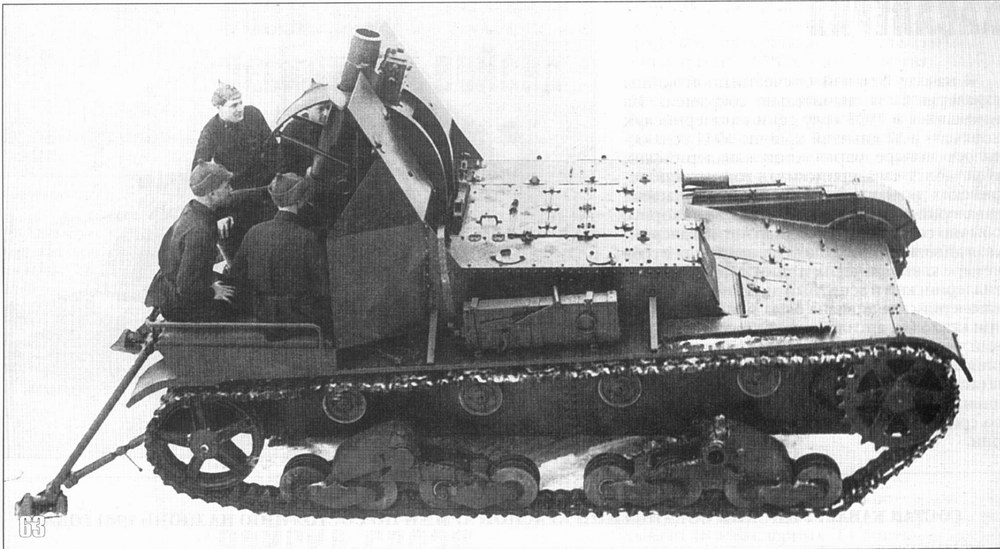
The SU-5 SPG, with a 75 mm (2.95 in) mortar. Only 33 were produced using T-26 chassis.
T-26 A43: The first artillery variant was a model 1933 chassis equipped with an A43 turret developed by engineer N. Dyrenkov for the RKKA experimental unit. The two-man turret housed an ordinance 75 mm (2.95 in) model 1927 gun and a coaxial DT machine-gun in a ball mount. This model, plagued by many flaws, like a lack of visibility and no ventilation for the turret, was never accepted by the army.
T-26-4: Also called T-26 A, “A” standing for “artilleriysky”. It was equipped with a bigger turret (similar to the one used by the T-28) designed by the Bolshevik Factory and sported a 76.2 mm (3 in) model 1927 gun. It was more successful and all tests were passed. Three were built with this gun and three others with the new, powerful and advanced PS-3 gun. However, it appeared quickly that the latter was too powerful for the T-26, causing blast damage to the turret ring, roof and suspension. After an accident during trials, the initial order for 50 machines was canceled. Other conversion attempts were abandoned due to risks of overloading the chassis.
SU-5: These models were relatively successful. 33 were developed by the Leningrad Factory of Experimental Mechanical Engineering. Flame-thrower variants:
These models were fitted with internal tanks for the flamethrower liquid, generally placed on the sides of the hull, and given to Chemical battalions. They fought in Manchuria, Finland and during various operations at the beginning of WW2.
TT-26 (TU-26): Remote-control tanks used for minelaying operations or to deal with fortifications. 162 were built in all.
ST-26: Bridge layer variant, of which 71 were produced.
There were many others, most being prototypes or short series, developed and built by the Leningrad Factory of Experimental Mechanical Engineering.
During the first engagements, the T-26 showed itself clearly superior to the bizarre collection of antiquated machines acquired from the most improbable sources and also to the tanks fielded by the Nationalists, ranging from Italians tankettes to the small Panzer I. Except for an ever present aviation threat, the T-26 ruled the battlefield and raised some concerns among German tank specialists. During the battle of Guadalajara (March 1937), Republican T-26s completely eradicated armored opposition (mostly CV-33 and 35 Italian tankettes). It was a stunning victory, but the last for the “Rojos”.
The first large engagement was the Changkufeng Incident, which occurred at Lake Khasan in July-August 1938, alongside the disputed Changkufeng Heights, near Korea. The 2nd Mechanized Brigade, 32nd and 40th Separate Tank Battalions went into action with their 276 tanks, ending with a Russian crushing victory. This was the prelude to the last, decisive battle of Nomonanh (Khalkin Gol) in 1939, concluded with a status quo with few territorial gains for the USSR.
Flame-thrower versions were notably used en masse against the Mannerheim line. However, the Finns, with excellent anti-tank guns and clever ad-hoc infantry tactics, butchered swarms of T-26s and demonstrated that this model had finally reached a state of obsolescence. Back in the USSR, it triggered an acceleration in tank design, towards the next generation of the forties. As a reward for their resilience, the Finns captured perhaps two hundred T-26s of all versions, which were refurbished and pushed back into service with the swastika in 1941 against their former owners. Some Finnish T-26s were still on active duty in 1960.
But despite a clear superiority over the German Panzer I, II and some parity with the Czech-built Panzer 35(t) and 38(t) fielded by the Wehrmacht, they were no match for the 50 mm (1.97 in) and 75 mm (2.95 in) armed Panzer III and IV which formed the main part of every Panzer Division. Their relatively thin armor could withstand Pak 36 gunfire, but not any other German antitank gun.
During the early stage of Operation Barbarossa, the Soviets lost thousands of T-26s, and not only due to enemy action. With the chaos following the German swift advance creating large pockets, many broke down or were immobilized because of the lack of spare parts, fuel and poor maintenance. But overall, enemy gunfire and air strikes took their toll. By December 1941, perhaps less than a third of existing T-26s in the USSR were left in eastern sectors and in the Far East. However, the remainder fought at Moscow, Stalingrad, in the Caucasus and on the Northern front (around Leningrad) as far as 1944.
Many of them were specialized variants. Those still in great numbers in the Far East, participated in the attack on Manchuria in August 1945, the last great offensive action of the war, against the Kwantung army. Some T-26s, part of those 82 sold to the Chinese nationalist forces in 1938-42, after being opposed to IJN forces and playing a significant role at the Battle of Kunlun Pass, fought against the communists in 1946-47.
“Soviet Light Tanks 1920-1941.” A.G. Solyankin, M.V. Pavlov, I.V. Pavlov, E.G. Zheltov / Советские легкие танки 1920-1941. А.Г. Солянкин, М.В. Павлов, И.В. Павлов, Е. Г. Желтов.
“Soviet Flame and Chemical Tanks 1929-1945.” A.G. Solyankin, M.V. Pavlov, I.V. Pavlov, E.G. Zheltov / Советские огнеметные и химические танки 1929-1945. А.Г. Солянкин, М.В. Павлов, И.В. Павлов, Е. Г. Желтов.
“T-26 Light Tank” Steven Zaloga, Osprey Publishing
Based on the Vickers Mark E
The Soviet T-26 was the illegitimate offspring of the successful Vickers Mark E export light tank. The “Vickers 6-ton” had no customers when it was first released, in 1931. However, this well-balanced, modern and relatively cheap tank immediately drew the attention of Soviet officers, who felt the need to keep in touch with western technologies.The previous Soviet mass-production tank, the T-18, a local design, was based on the small WWI era Renault FT. One decade had already passed, and the new Vickers tank embodied the advances of the time, or so they were advertised. This confidence in Vickers designs was renewed after the license for the Carden-Loyd Mk.VI tankette was acquired, built locally as the T-27. Another Vickers design also led to the amphibious T-37A. At the first press meetings and public tests, the tank drew the attention of Semyon Ginzburg, head of the Soviet buying committee, searching for tractors, cars, trucks and tanks.
They signed a contract for 15 Vickers 6-ton Model A (twin-turret) vehicles was signed on May 28, 1930, including full documentation and plans for domestic production. The 15 tanks were assembled in 1930 at Vickers, under the careful attention of Soviet engineers. The first vehicles arrived in the USSR during that fall, and the others in 1931-32 when the first domestic T-26 design was almost ready for production.
The most produced tank of the thirties
The T-26 was, at the time, by far the most produced tank in the world, to a level which could only be achieved in the USSR. At that time, Stalin desperately pushed this gigantic rural country to a forced, careless march towards industrial might. With less engineering sophistication than contemporary western models, the T-26 was ideally suited for mass-production and ultimately the 10,000th vehicle was built in September 1939.This tank alone made the Red Army, by far, the biggest armored force the world had ever seen. Even in the summer of 1941, German armor was overwhelmed by a four to one ratio and the Panzers would soon be confronted, on a daily basis, with swarms of such light tanks. Simply put, it was the mainstay of the Red Army, playing the same task during these pre-war years as the T-34 during the “Great Patriotic War”.
Development
In 1931, the first three British Vickers tanks, under the designation of V-26, successfully passed all tests at the Poklonnaya Hill proving ground near Moskow. At the same time, S.Ginsburg had already conceived the T-19, a possible competitor for the Vickers, and the Special Commission for the Red Army (RKKA) was charged with seeking the better of the two for the needs of the Red Army.But as the complex T-19, although not ready on schedule, had some advantages over the Vickers, Ginsburg suggested the construction of a kind of hybrid, retaining only the engine and transmission from the Vickers. However, in January 1931, there were serious concerns about the purchase of the Vickers and Christie tanks by Poland, with mass-production possible afterward. At that time, the USSR only possessed an obsolete lot of WWI vintage British and French tanks and the now obsolescent fleet of T-18s.
So an order came to urge production of the T-26 with existing components. There were concerns about the better quality of British armor (the Vickers S.t.a Plat, high-quality cemented plates). This first prototype was a Vickers equipped with Soviet-built turrets, which was put under heavy machine-gun fire to check protection.
At the same time, the Faculty of Mechanization and Motorization of the Military Technical Academy produced two “low power tanks”, TMM-1 and TMM-2, proceeding with several engines and parts from other vehicles. They were not retained and the final T-26, if very close to the original Vickers, had many alterations. The T-26 was first produced by the Bolshevik Factory in Leningrad, the only one with equipment and significant experience, having recently mass-produced the T-18.
Later on, Factory No. 174 joined the effort, headed by chief engineer S. Ginzburg. But until 1935 quality flaws were frequent. In 1933, the production was also assumed by the Stalingrad Tractor Factory (STZ). In February 1941, the last T-26 left Factory N°174. The production lines were converted to the more complex T-50 but still managed to build spare parts, armor kits, turrets and convert about 130 T-26s as flame-throwing versions, with a KhT-133 device. They also repaired around 846 T-26 in active duty. T-26 model 1931-32: The twin-turret version
The earliest production model was a twin-turret type. Each turret had an observation slit, a round firing port for the DT machine-gun, armored plates riveted to a frame and even sealed zinc shims for improved waterproof performance and fording. The following year, a cover for the engine main air outlet window was added. The next models (1932-33) had a mixed construction, with a welded and riveted hull. Turrets were either riveted or welded, sometimes both, mixed with all-welded or riveted hulls.
These turrets existed in four different models and configurations, although still mounted in the same locations, with the same height and generally same features. All had a 240° arc of fire and armor ranging from 13 to 15 mm (0.51-0.59 in), although the very first 1931 models had only 10 mm (0.39 in) of mediocre alloy, susceptible to machine-gun fire. The model 1931 (100 units), 1932 (1361) and 1933 (576) were all twin-turreted versions. About 2038 were built in all. Their fighting value in 1939 was insignificant, so many were converted to other duties, and some for training.

T-26 early production version (model 1932) under maintenance.
T-26 model 1933
The biggest production run of the T-26 was the single-turret variant. In fact, it was inspired by the British Vickers 6-tons Type B, but both the turret and armament were purely Soviet in design. The turret was cylindrical, relatively low, simple in design, with rear storage, housing a high velocity 45 mm (1.77 in) gun with antitank capabilities. This was in stark contrast to the British Type B’s low velocity 37 mm (1.46 in) gun, designed for infantry support.The Soviet gun, the 19K model 1932, was supplied with 122 rounds. Secondary armament consisted of a frontal coaxial 7.62 mm (0.3 in) DT machine gun and an additional one mounted on a rear external anti-aircraft cradle. In 1935, an extra one was mounted in a turret rear ball mount, all supplied by a total of 2961 rounds. These three machine-guns were provided to cope with dedicated anti-tank crews and effectively did their job against Japanese suicide squads at the battle of Khalkin Gol in 1939 (Mongolia). The 19K (and later 20K) 45 mm (1.77 in) guns fired anti-tank rounds with a muzzle velocity of 820 m/s (2,700 ft/s), but a supply of traditional high explosive rounds were also carried.
By 1933, only commander tanks were equipped with radios, the early model presenting the cumbersome hand-rail radio antenna on the turret, while later ones had the more conventional buggy-whip antenna. This later type was a product of the experience both during the Spanish Civil War and various incidents with Japan on the Chinese-Mongolian border, showing that visible commander tanks were more likely to be targeted.
The drivetrain and transmission were both straightforward designs. The small but torque-full 90 bhp flat row 4-cylinder air-cooled petrol engine was a very careful copy of the British Armstrong Siddeley. It was somewhat simplified for mass-production and adapted to harsher climates, extreme both in summer and winter. Its major flaw was the absence of a mechanical speed limiter, which caused overheating and accidental breakdowns at first.
This engine also required top-grade refined petrol to run in good order. It was ventilated by a cooling fan mounted in a special shroud and the exhaust muffler was affixed by three clamps. The engine was alimented by an 182 l fuel tank, upgraded in 1932 to 290 l, increasing the overall autonomy.
The transmission included a single-disk main dry clutch and five gear gearbox. It was mounted in the front part of the hull. The original two-boggy, four twin rubber-covered road wheels suspension was kept. The cast box connecting these wheels was suspended by balancing levers and two one-quarter elliptic leaf springs. The drive wheel with removable sprocket ring was at the front and the idler at the rear (with a crank lever tightener). The 108-109 chrome-nickel steel links tracks were supported with four twin return rollers. The T-26 was reputedly easy to drive and capable of fording 80 cm (2.62 ft) of water, crossing 75 cm (2.46 ft) high obstacles and 2.1 m (6.89 ft) wide trenches.
T-26 model 1938
From 1933 to 1938 the T-26 was virtually unchanged, except for the use of buggy-whip antennae, VKU-3 command system, TPU-3 intercom and an electric breechblock and vertically stabilized (or TOS model) TOP-1 gun telescopic sight. The main armament will remain unchanged until the end of the production in 1941, but the model 1938 received a brand new cast turret with sloped angles, the same armor and a PTK commander’s panoramic sight for newly radio-equipped commander tanks.This turret was also factory-equipped with a rear gun port, first introduced in 1935, for a third DT machine-gun. After the battle of Lake Khasan in August 1938, the turret base was reinforced with a sloped underturret plate, 20 mm (0.79 in) strong. This late model was called the model 1939 or T-26-1 in some sources. In all, 4,826 model 1938 and 1939 tanks were built. Around 670 of these were fitted with AA machine-gun mounts in 1939-40.
At the same time, many obsolescent twin-turret models were converted as flame-throwers or dispersing tanks for chemical battalions. In 1940, the Factory of Carrying-and-Conveying Machines S. Kirov in Leningrad was responsible for the modernization of 340 1933 models T-26, replacing older road wheels with new reinforced ones. Other change included some armor increase for the headlight, driver’s hatch lower door and new armored PT-1 or PTK observation devices were fitted, as well as a common hatch above the engine compartment and fuel tank access. The latter’s capacity was increased. This unit and Factory N°105 were responsible for repairing many disabled T-26s.
T-26 variants
Model 1931 twin turret variants
Mixed armament (gun and machine-gun) model 31 The first 10 pre-series vehicles were equipped with mixed armament, one of the turrets being equipped with a Russian variant PS1 or PS2 of the French Hotchkiss 37 mm (1.46 in) gun, designed by engineer P. Syachentov. Only three later model 1931s were fitted with the PS2 gun in the right turret, but ultimately 392 were converted later to this configuration.The T-26 BKP were 20 or 30 vehicles equipped with the B3 recoilless gun designed by engineer L.V. Kurchervsky in 1933. These 1934 models were few because of the shortcomings of the “dynamic reaction gun”, as it was called. Although the muzzle velocity (500 m/s or 1640 ft/s) and range (4 km/2.48 mi) made them very effective as anti-tank weapons, they were impossible to reload on the move, the procedure being long and uneasy, fully exposing the gun crew and the rear jet blast proving dangerous for accompanying troops.
T-26TU: This twin-turret variant was the command tank model 1931, with a hand-rail frame antenna affixed on the hull. Because they were to be equipped with the No.7N simplex radio, then in short supply, only three were converted.
T-26E: The “E” stands for “ekranirovanny” (screened). The vehicle was protected by additional appliqué armor, made of 30-40 mm (1.18-1.57 in) iron plates bolted to the hull and turret, developed by Factory No. 174 on the eve of the Winter war, in 1939. This armor, assembled by blunt bolts and electric welding, was adaptable to either model 1933 or model 1938 tanks. They were strong enough to stop a 45 mm (1.77 in) anti-tank shell fired at short range (400 m/1312 ft).
As it was shown during the Winter War, no Finnish anti-tank gun was powerful enough to do any damage. During operation Barbarossa, these up-armored T-26s, although much slower, also proved resistant to many German guns. However, only a few were converted, RKKA receiving 69 modified T-26E models, including some flame-thrower versions.
Self-propelled artillery variants

The SU-5 SPG, with a 75 mm (2.95 in) mortar. Only 33 were produced using T-26 chassis.
T-26 A43: The first artillery variant was a model 1933 chassis equipped with an A43 turret developed by engineer N. Dyrenkov for the RKKA experimental unit. The two-man turret housed an ordinance 75 mm (2.95 in) model 1927 gun and a coaxial DT machine-gun in a ball mount. This model, plagued by many flaws, like a lack of visibility and no ventilation for the turret, was never accepted by the army.
T-26-4: Also called T-26 A, “A” standing for “artilleriysky”. It was equipped with a bigger turret (similar to the one used by the T-28) designed by the Bolshevik Factory and sported a 76.2 mm (3 in) model 1927 gun. It was more successful and all tests were passed. Three were built with this gun and three others with the new, powerful and advanced PS-3 gun. However, it appeared quickly that the latter was too powerful for the T-26, causing blast damage to the turret ring, roof and suspension. After an accident during trials, the initial order for 50 machines was canceled. Other conversion attempts were abandoned due to risks of overloading the chassis.
SU-5: These models were relatively successful. 33 were developed by the Leningrad Factory of Experimental Mechanical Engineering. Flame-thrower variants:
These models were fitted with internal tanks for the flamethrower liquid, generally placed on the sides of the hull, and given to Chemical battalions. They fought in Manchuria, Finland and during various operations at the beginning of WW2.
Special duty variants
T-26T: These were turretless artillery tractor variants, of which 197 were produced.TT-26 (TU-26): Remote-control tanks used for minelaying operations or to deal with fortifications. 162 were built in all.
ST-26: Bridge layer variant, of which 71 were produced.
There were many others, most being prototypes or short series, developed and built by the Leningrad Factory of Experimental Mechanical Engineering.
Battle records and active service
Being one of the most widely produced tanks in history, the T-26 was also one of the most well-balanced, at least during the 1930s. It was a perfect compromise between reasonable speed, good armor and generous firepower. It was not a pure infantry tank, nor a fast cruiser tank, but a modern, well-balanced light tank, versatile, relatively cheap and easy to maintain. During its long career, starting in Spain and ending in China, it was not only used by the Soviets, but by Spanish Republican forces, the Finns and Germans (captured ones), nationalist Chinese, Turkey (60 sold), Romania and Hungary (captured during Operation Barbarossa) and even Afghanistan.The Spanish Civil War
After years of training with the BT and T-26, which formed the bulk of Soviet tank force, the first engagement came in Spain, during the Civil War. The “natural ally” of the socialist and communist dominated Republican party was the USSR. The Soviets sold them a total of 281 T-26 tanks (297 according to other sources), starting in October 1936, alongside a dozen BT-5s and hundreds of armored cars.During the first engagements, the T-26 showed itself clearly superior to the bizarre collection of antiquated machines acquired from the most improbable sources and also to the tanks fielded by the Nationalists, ranging from Italians tankettes to the small Panzer I. Except for an ever present aviation threat, the T-26 ruled the battlefield and raised some concerns among German tank specialists. During the battle of Guadalajara (March 1937), Republican T-26s completely eradicated armored opposition (mostly CV-33 and 35 Italian tankettes). It was a stunning victory, but the last for the “Rojos”.
Soviet-Japanese border conflicts
By 1935, the Soviets had reclaimed former Far Eastern Tsarist territories. The new borders of the USSR, now reclaimed with full force, encompassed Korean, Chinese and Mongolian frontiers. Northeast China and its blurry frontiers (the landscape of these remote, icy cold, bone dry wastelands didn’t help either) had been, starting in 1905, a source of vivid tensions between Moscow, Pekin, and Tokyo. The South Manchurian Railway especially became the casus belli which triggered the second Sino-Japanese war, as well as hundreds of “border incidents” (ranging from mere infantry skirmishes to fully fledged large scale battles) fought between Mongolian or Soviets forces against the IJA.The first large engagement was the Changkufeng Incident, which occurred at Lake Khasan in July-August 1938, alongside the disputed Changkufeng Heights, near Korea. The 2nd Mechanized Brigade, 32nd and 40th Separate Tank Battalions went into action with their 276 tanks, ending with a Russian crushing victory. This was the prelude to the last, decisive battle of Nomonanh (Khalkin Gol) in 1939, concluded with a status quo with few territorial gains for the USSR.
Invasion of Finland
In the west, the uneasy non-aggression pact between Hitler and Stalin, which helped them buy extra time to strengthen and prepare their armies, was celebrated in the blood of their common hatred neighbor, Poland. Most of the Soviet armored forces which participated were made of separate T-26s light tank brigades. Three months later, the same units formed the brunt of an even bigger invasion force on Finland’s southeastern frontier (Karelian Isthmus).Flame-thrower versions were notably used en masse against the Mannerheim line. However, the Finns, with excellent anti-tank guns and clever ad-hoc infantry tactics, butchered swarms of T-26s and demonstrated that this model had finally reached a state of obsolescence. Back in the USSR, it triggered an acceleration in tank design, towards the next generation of the forties. As a reward for their resilience, the Finns captured perhaps two hundred T-26s of all versions, which were refurbished and pushed back into service with the swastika in 1941 against their former owners. Some Finnish T-26s were still on active duty in 1960.
Eastern front during World War Two
In June 1941, the Red Army had 10,268 T-26 tanks of all models and variants. The last produced, a T-26 model 1939, ran out of the factory line in February. But despite moderate modernization, the T-26 felt its age. The first sketches of their ancestor, the British Mark E, were drawn in 1928. They formed the bulk, by far, of every mechanized corps in border military districts.But despite a clear superiority over the German Panzer I, II and some parity with the Czech-built Panzer 35(t) and 38(t) fielded by the Wehrmacht, they were no match for the 50 mm (1.97 in) and 75 mm (2.95 in) armed Panzer III and IV which formed the main part of every Panzer Division. Their relatively thin armor could withstand Pak 36 gunfire, but not any other German antitank gun.
During the early stage of Operation Barbarossa, the Soviets lost thousands of T-26s, and not only due to enemy action. With the chaos following the German swift advance creating large pockets, many broke down or were immobilized because of the lack of spare parts, fuel and poor maintenance. But overall, enemy gunfire and air strikes took their toll. By December 1941, perhaps less than a third of existing T-26s in the USSR were left in eastern sectors and in the Far East. However, the remainder fought at Moscow, Stalingrad, in the Caucasus and on the Northern front (around Leningrad) as far as 1944.
Many of them were specialized variants. Those still in great numbers in the Far East, participated in the attack on Manchuria in August 1945, the last great offensive action of the war, against the Kwantung army. Some T-26s, part of those 82 sold to the Chinese nationalist forces in 1938-42, after being opposed to IJN forces and playing a significant role at the Battle of Kunlun Pass, fought against the communists in 1946-47.
T-26 specifications | |
| Dimensions (L-w-h) | 4.55 m x 2.31 m x 2.30 m (14ft 11in x 7ft 7in x 7ft 7in) |
| Total weight, battle ready | 9.6 tons |
| Crew | 3; Cdt, Gunner, Loader |
| Propulsion | 4-cyl gas flat air cooled Armstrong-Siddeley, 90 bhp |
| Speed (road / off-road) | 31/16 km/h (19.3/9.9 mph) |
| Range (road / off-road) | 240/140 km (150/87 mi) |
| Armament | Early 2xDT 7.62 mm (0.3 in)LMG, Later 45 mm (1.77 in) VK + 1 DT MG |
| Armor | 6 to 15 mm (0.24-0.59 in) |
| Track | 28 cm (11 inches) on 12.5 cm (4.9 inches) |
| Total production | 10,300 |
Sources
“Tough Armor: History of the Soviet Tank 1919-1937” Mikhail Svirin / Броня крепка: История советского танка 1919-1937. Михаил Свирин.“Soviet Light Tanks 1920-1941.” A.G. Solyankin, M.V. Pavlov, I.V. Pavlov, E.G. Zheltov / Советские легкие танки 1920-1941. А.Г. Солянкин, М.В. Павлов, И.В. Павлов, Е. Г. Желтов.
“Soviet Flame and Chemical Tanks 1929-1945.” A.G. Solyankin, M.V. Pavlov, I.V. Pavlov, E.G. Zheltov / Советские огнеметные и химические танки 1929-1945. А.Г. Солянкин, М.В. Павлов, И.В. Павлов, Е. Г. Желтов.
“T-26 Light Tank” Steven Zaloga, Osprey Publishing

The first early production T-26 or “model 1931”. It had two turrets, being the domestic version of the Vickers Mark E. This model, with unit red stripes, was posted with border units in case of a Polish attack, a constant worrying of the general staff in 1932. The Polish army had just acquired the Vickers Mark E (6-ton) license and, like the USSR, would produce a new home-based model, the 7TP. Interestingly enough, the first ten preseries tanks were all equipped with mixed armament, the right turret being equipped with a low velocity 37 mm (1.46 in) derived from the French Puteaux.
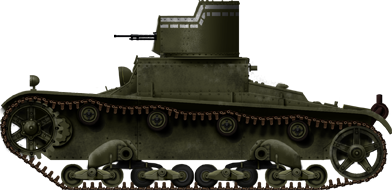
Soviet T-26 model 1932 at Khalkin Gol, August 1939. All mod. 1932 tanks were twin-turreted and most were equipped solely with DT machine guns.
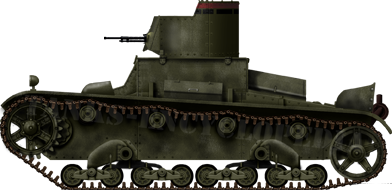
A 1933 late twin-turret T-26. Many of these were retrofitted to the model 1935 standard.
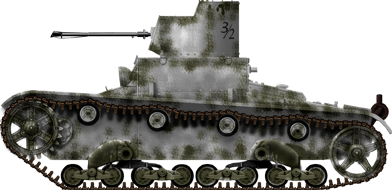
A HT-26 (converted from a model 1931) of the 210th Separate Chemical Tank Battalion, Karelian Isthmus, January 1940. The tactical unit number is on the rear part of the turret.
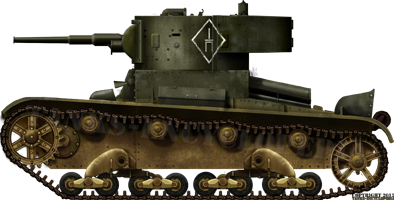
A model 1933 single turret T-26. Unknown unit. In this configuration, there was a single high-velocity 45 mm (1.77 in) gun firing conventional HE and AP rounds and two DT 7.62 mm (0.3 in) machine-guns, one coaxial and one in a removable anti-aircraft mount, at the rear of the turret. It was rarely mounted in practice, but showed itself useful in Mongolia in 1939 when repelling waves of Japanese anti-tank infantry squads.
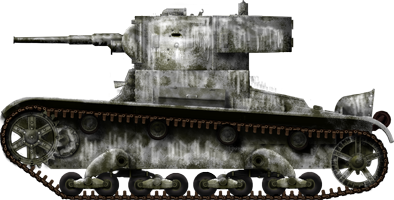
A model 1933 T-26 hastily hand-painted white during the Winter War in Finland, unknown unit, Karelian Isthmus, December 1939.
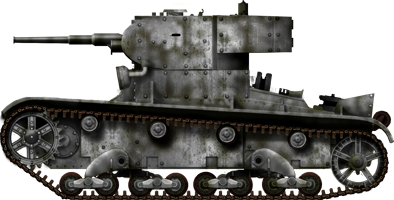
T-26 model 1934 Ehkranami, up-armored with extra 30-40 mm (1.18-1.57 in) bolted plates, 5th Armored Brigade, Leningrad sector, November 1941.

A model 1933 (in reality produced in 1936) T-26 of the Nationalist forces, Spain, battle of Guadalajara, March 1937. This one was part of the first shipments which were made to the Spanish Republicans from the USSR, and it was later captured and pressed into service by the Nationalists. The Soviets claim to have shipped 362 tanks, but with losses at sea and returned shipping, perhaps only 281 to 297 T-26s were actually delivered. It was by far the best tank deployed in this conflict. Its armor and main gun were superior to anything the Italians and German could deploy.
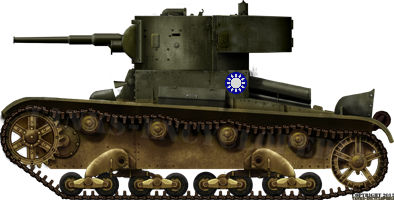
Kuomintang (Chinese Nationalist) T-26 of the 200th Division.
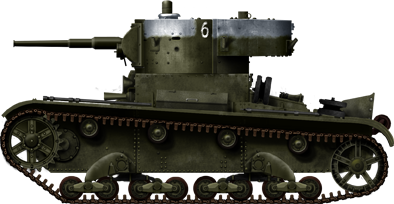
T-26 model 1935 of the 39th Tank Division, part of the 16th Mechanized Corps. Uman, early August 1941.
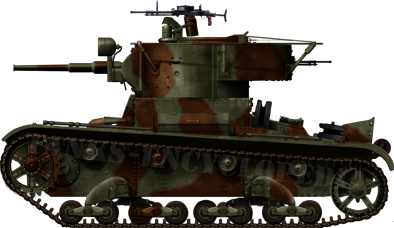
A T-26 model 1936-37 command tank version, with the characteristic hand-rail radio antenna, extra twin headlights, a DT P40 anti-aircraft mount and rear turret DT mount. Unknown unit, Mongolian frontier, August 1939.
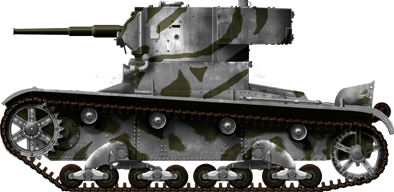
T-26 model 1933 built in 1937, 20th Tank Brigade. Western Front, November 1941.
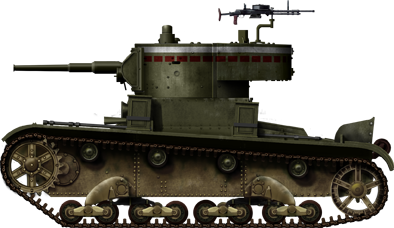
T-26 model 1933, equipped with additional storage and a rear-turret aerial machine-gun DT mount. Unknown unit, battle of Khalkin Gol, August 1939.
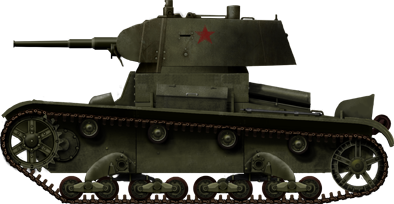
T-26 (welded hull) model 1938, 6th Armored Brigade, South-Eastern Front, August 1942. The model 1938 introduced a brand new turret with sloped armor as a compromise between the need for extra protection and the limitations of the original licence-built Armstrong Siddeley engine.
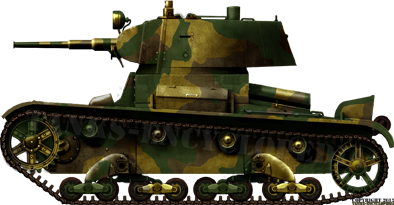
T-26 model 1938, unknown unit, South-East Front, Russo-British invasion of Persia, August 1941. This three-tone livery pattern was unusual, but seemed specific to the tanks involved in this particular operation, as photographic evidence testifies.
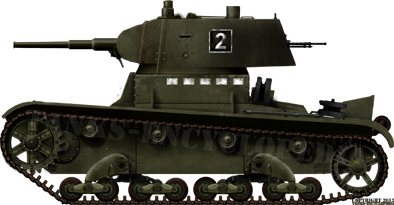
T-26 model 1938 positioned on the Far East Border with Manchuria, August 1940. Note the rear DT mount.
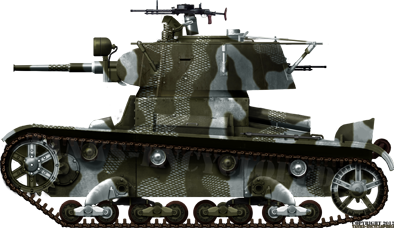
T-26 model 1938 with winter camouflage, with the strange “grid” pattern which can be found in many photographic archives. It seems to have been used to create a third tone, seen at great distances, without the need of an extra color. Central front, Battle of Moscow, winter 1941/42.
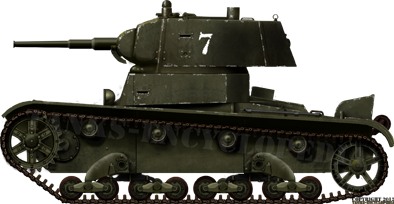
T-26 model 1939, unknown unit, Polish invasion, September 1939.
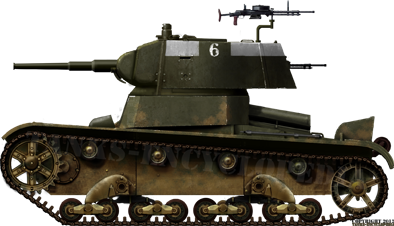
T-26 model 1939, 39th Tank Division of the Red Army’s 16th Mechanized Corps, Uman, August 1941.
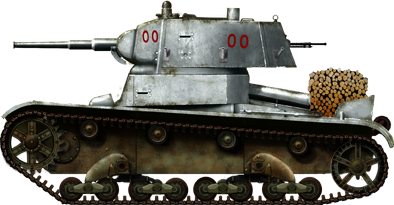
T-26 model 1939, possibly of the 40th Light Brigade, Karelian Isthmus, Finland, winter 1939.
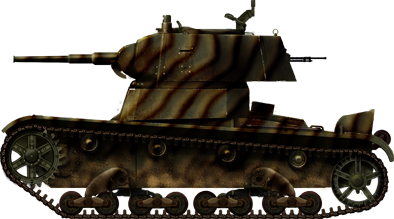
A T-26 with a three-tone vermicelli camouflage pattern. This strange livery is present in several photographs, belonging to the 18th Tank Division of the Red Army’s 7th Mechanized Corps. Belarus, early July 1941.
Surviving T-26 tanks
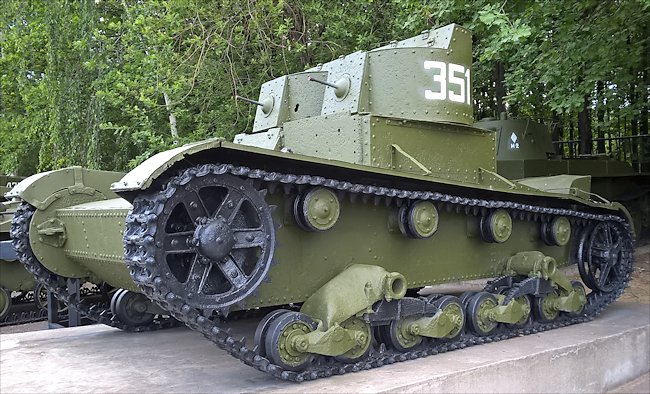
Red Army T-26 twin-turret light tank model 1931 at the Central Museum of the Great Patriotic War Museum 1941 – 1945, Park Pobedy, Moscow, Russia
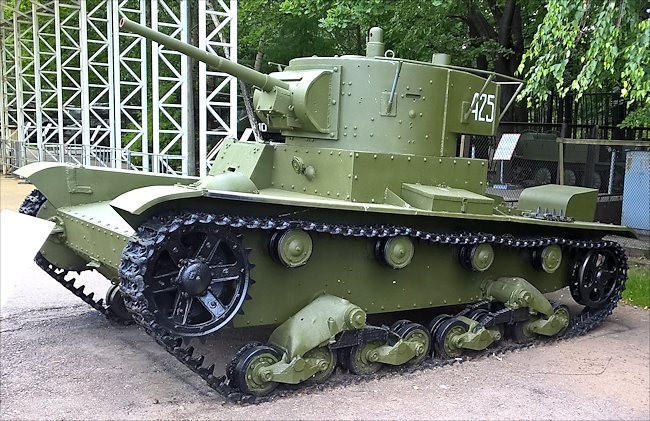
T-26 model 1933 tank with radio at the Central Museum of the Great Patriotic War 1941 – 194, Park Pobedy, Moscow, Russia
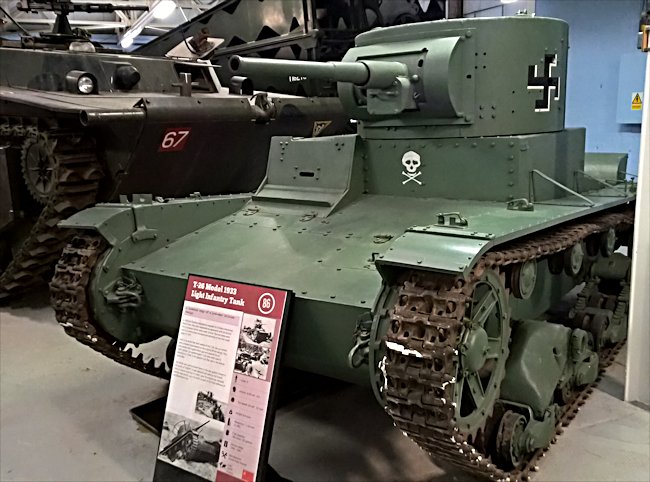
T-26 tank captured by the Finnish and painted in their markings – not German markings
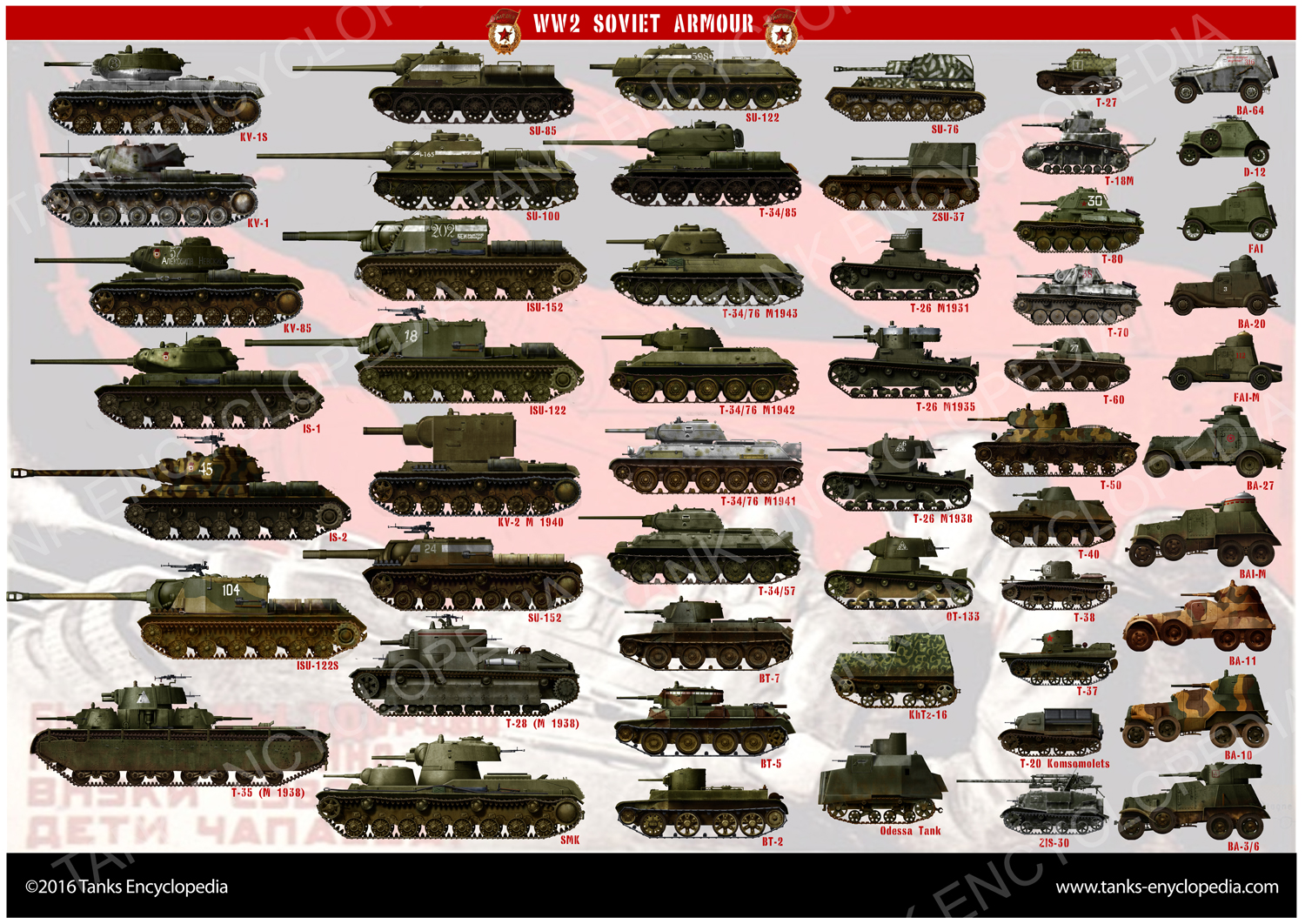
ww2 Soviet Tanks Poster

WW2 Tanks




























WW2 tanks posters

All Tiger tanks liveries.

Panther liveries and variants

WW2 Armour - All tanks











Tanks aces and single tanks series

Find more there

Museums, Movies, Books & Games
The Tanks and Armor in pop culture
Tanks and armored vehicles in general are only really grasped when seen first person: The mass, the scale, it's all there. Explore also the way tanks were covered in the movie industry, in books and in video games.Movies:
Best tanks movie on warhistoryonline.com
On imdb.com
On bestsimilar.com/
miltours.com
liveabout.com/
watchmojo.com
Video Games:
pcgamesn.com
historyhit.com
levvvel.com
vg247.com/best-tank-games
mmobomb.com/
alienwarearena.com

